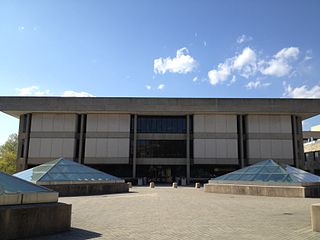A Bachelor of Fine Arts (BFA) is a standard undergraduate degree for students for pursuing a professional education in the visual, fine or performing arts. It is also called Bachelor of Visual Arts (BVA) in some cases.

Shenkar College of Engineering, Design and Art is a public college in Ramat Gan, Israel. Shenkar serves the Israeli industry by providing academic qualification and R&D services for modern industries. Shenkar is also considered as the top design school in Israel.
The Karlsruhe University of Arts and Design (HfG) is a state art college founded in 1992 in Karlsruhe. It focuses on media art, communication design, product design, exhibition design and scenography, art research and media philosophy with a strong interdisciplinarity between the departments. The university has about 400 students.

An art school is an educational institution with a primary focus on the visual arts, including fine art – especially illustration, painting, photography, sculpture, and graphic design. Art schools can offer elementary, secondary, post-secondary, or undergraduate programs, and can also offer a broad-based range of programs. There have been six major periods of art school curricula, and each one has had its own hand in developing modern institutions worldwide throughout all levels of education. Art schools also teach a variety of non-academic skills to many students.

The HKU University of the Arts Utrecht is a performing arts and visual arts educational institution in Utrecht, Netherlands.
The Academy of Fine Arts, Munich is one of the oldest and most significant art academies in Germany. It is located in the Maxvorstadt district of Munich, in Bavaria, Germany.

The Bauhaus-Universität Weimar is a university located in Weimar, Germany, and specializes in the artistic and technical fields. Established in 1860 as the Great Ducal Saxon Art School, it gained collegiate status on 3 June 1910. In 1919 the school was renamed Bauhaus by its new director Walter Gropius and it received its present name in 1996. There are more than 4000 students enrolled, with the percentage of international students above the national average at around 27%. In 2010 the Bauhaus-Universität Weimar commemorated its 150th anniversary as an art school and college in Weimar.

Zayed University is a public university based in the United Arab Emirates. It was established in 1998. It is one of the three government-sponsored higher education institutions in the United Arab Emirates. It is named in honor of Sheikh Zayed bin Sultan Al Nahyan, the country's first president.

Illinois Institute of Art – Chicago was a for-profit art and culinary school, which briefly operated as a non-profit institution before it closed in 2018. The school was one of a number of Art Institutes, a franchise of for-profit art colleges with many branches in North America, owned and operated by Education Management Corporation. EDMC owned the college from 1975 until 2017, when, facing significant financial problems and declining enrollment, the company sold the Illinois Institute of Art – Chicago, along with 30 other Art Institute schools, to Dream Center Education, a Los Angeles-based Pentecostal organization.

The Free University of Bozen-Bolzano is a university primarily located in Bolzano, South Tyrol, Italy. It was founded on 31 October 1997 and is organized into five Faculties.

The Academy of Fine Arts, Prague is an art college in Prague, Czech Republic. Founded in 1799, it is the oldest art college in the country. The school offers twelve master's degree programs and one doctoral program.

The University of Nicosia was established in 1980 and its main campus is located in Nicosia, the capital city of Cyprus. It also runs study centres in Athens, Bucharest and New York.
The Gustav Siewerth Academy (GSA) is a private university based in Weilheim-Bierbronnen in Baden-Wuerttemberg, Germany, dedicated to promote a Christian world view. The university became recognized as an institution of higher education in Germany in 1988. However, that recognition is disputed. The Academy is named after philosopher and pedagogue Gustav Siewerth and with only 13 students in 2012–13, was the smallest state-recognized institution of higher education in Germany.
Christoph Dreher is a German filmmaker, musician and scriptwriter. From 2000 until 2020, he was a professor of audiovisual media.
Flashpoint Chicago is a non-profit campus of Columbia College Hollywood, a private liberal arts college with a focus on communication, media arts, and contemporary storytelling. Flashpoint Chicago is located in downtown Chicago, Illinois.

The College of Architecture, Arts, and Design formerly the College of Architecture and Urban Studies at Virginia Tech consists of four schools, including the School of Architecture, which consistently ranks among the best in the country. Headquartered in Blacksburg, Virginia, the college also has sites in Alexandria, Virginia and Riva San Vitale, Switzerland. Spread out among these three locations, the college consists of nearly 2,200 students, making it one of the largest schools of architecture in the nation.
Paris College of Art, previously called Parsons Paris until 2010, is an international college of art and design with U.S degree-granting authority and accreditation from the National Association of Schools of Art and Design (NASAD) located in Paris, France. PCA's mission is to provide the highest standard of art and design education, taught within an American pedagogical paradigm, while being influenced and informed by their French and European environment.

Zurich University of the Arts has approximately 2,500 students, which makes it the largest arts university in Switzerland. The university was established in 2007, following the merger between Zurich's School of Art and Design (HGKZ) and the School of Music, Drama, and Dance (HMT). ZHdK is one of four universities affiliated to Zürcher Fachhochschule.

The State Academy of Fine Arts Stuttgart is a university in Stuttgart, Germany. Founded on 25 June 1761, and located since 1946 on the Weißenhof, the Academy, whose historical significance marks names such as Nicolas Guibal, Johann Heinrich von Dannecker, Bernhard Pankok, Adolf Hölzel, Willi Baumeister, Herbert Hirche, K.R.H. Sonderborg, Alfred Hrdlicka, Heinz Edelmann, Marianne Eigenheer, Richard Sapper, Joseph Kosuth, David Chipperfield, Joan Jonas, Micha Ullman, offers from all art universities in the federal state Baden-Württemberg the largest numbers of courses, namely all disciplines of the visual field, and not just in an organizational network but also under one roof. This is essentially the result of the connection of the former Academy of Fine Arts with the former School of Applied Arts in 1941 as Staatliche Akademie der bildenden Künste Stuttgart, which was reconstituted by Theodor Heuss in 1946 under the same name and which aimed at a broad training program as well as an intensified development in the following decades. Under the rectorate of Wolfgang Kermer, on 22 February 1975, the ″Gesetz über die Kunsthochschulen im Lande Baden-Württemberg (Kunsthochschulgesetz)″ passed by the Landtag of Baden-Württemberg came into force, which for the first time in the history of the State Academy of Fine Arts Stuttgart regulated the status and the essential relationships and which guaranteed the equality of rank with universities.
Wolfgang Kermer is a German art historian, artist, art educator, author, editor, curator of exhibitions and professor. From 1971 to 1984 he was repeatedly elected Rector of the State Academy of Fine Arts Stuttgart and thus the first scientific and at the same time youngest teacher in this position in the history of the university. Under his rectorate, the State Academy of Fine Arts Stuttgart was reformed in 1975 and 1978 on the base of two new university laws of the State of Baden-Württemberg and thus, for the first time in its history, authorized to set up diplomas for all courses. His focus is the history of Visual arts education, the art of Willi Baumeister and the history of the State Academy of Fine Arts Stuttgart and its predecessor institutions. He was the publisher and editor of the publication series Akademie-Mitteilungen (1972–1978), Beiträge zur Geschichte der Staatlichen Akademie der Bildenden Künste Stuttgart (1975–2004), WerkstattReihe (1996–2006) and ″Die Staatliche Akademie der Bildenden Künste Stuttgart im Spiegel der Presse 1970/1971″ (2008). On the occasion of his 75th birthday, the Stuttgarter Nachrichten called Wolfgang Kermer ″the memory of the Stuttgart Art Academy″.












